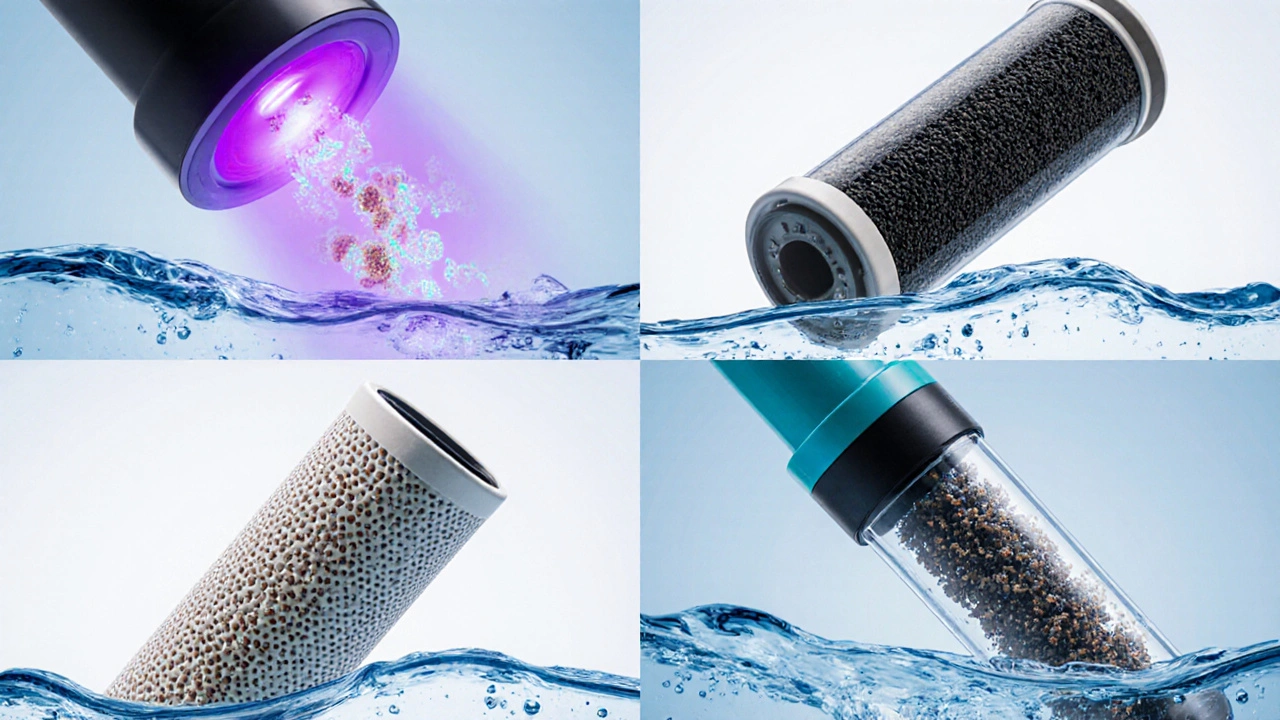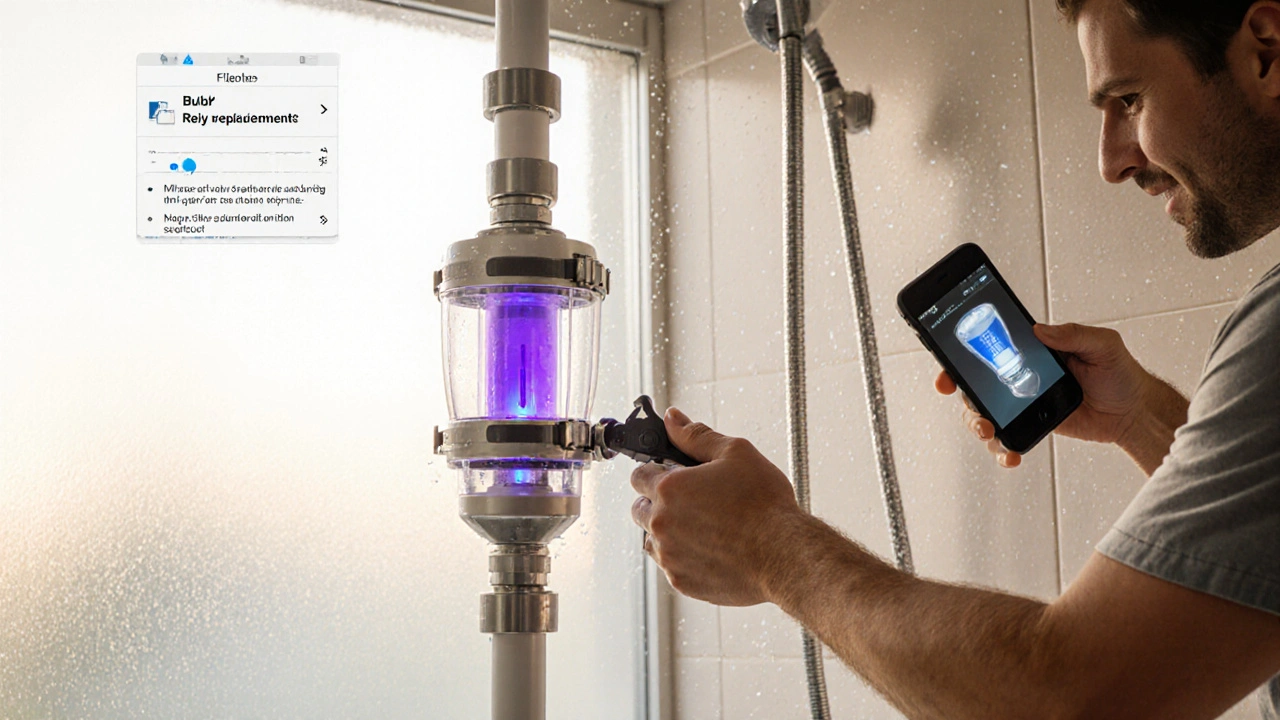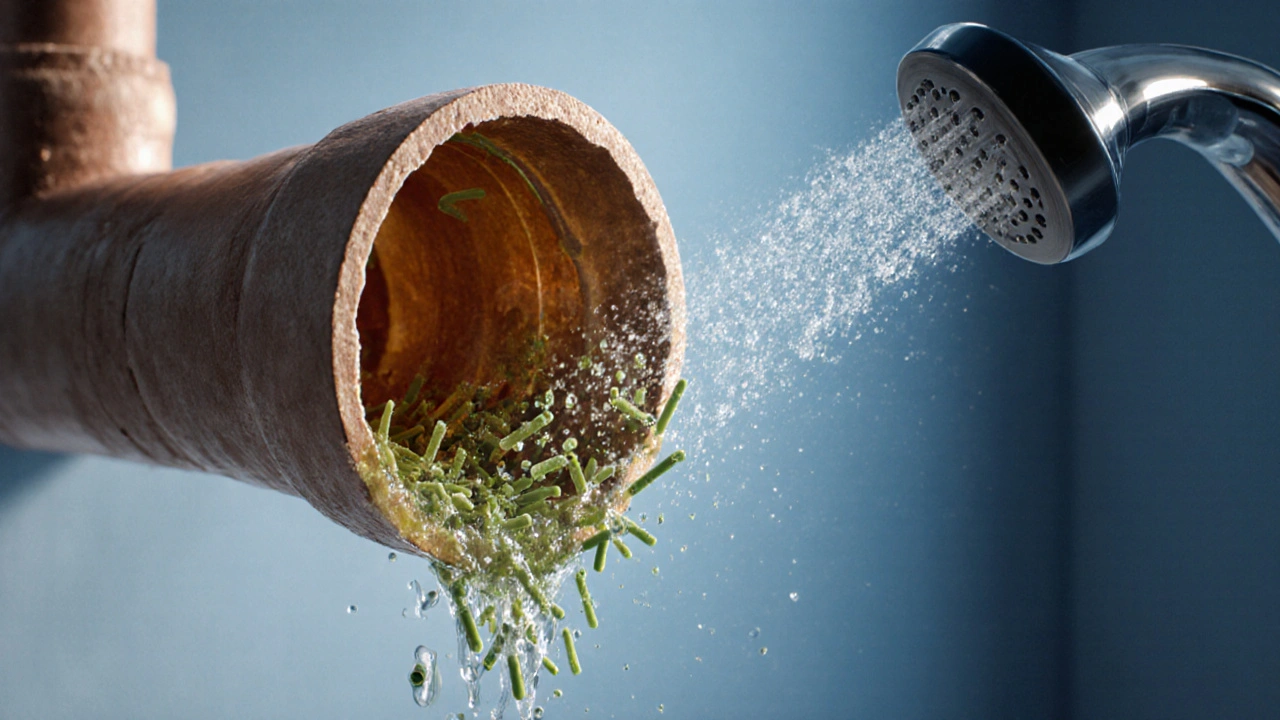Legionella Filter Comparison Tool
Use this tool to compare the effectiveness of different water filtration technologies against Legionella bacteria. Select your preferred filter type to see how well it protects against this dangerous pathogen.
Filter Performance Results
Effectiveness:
Cost:
Maintenance:
Best Use Case:
Important Notes:
- UV effectiveness drops significantly when flow exceeds 5 GPM
- Carbon filters primarily reduce nutrients that feed bacteria
- Ceramic filters offer size-exclusion protection
- Membrane filters provide the highest level of physical barrier protection
UV Filtration
Uses UV-C light (254 nm) to damage bacterial DNA. Effective for water temperatures up to 45°C and flow rates under 5 GPM.
Activated Carbon
Adsorbs organic compounds and nutrients that feed bacteria. Limited physical barrier against Legionella.
Ceramic
Porous matrix blocks bacteria through size exclusion. Good for cold-water applications.
Membrane (UF/RO)
Ultra-filtration or reverse-osmosis membranes provide physical barrier protection down to 0.01 µm.
Key Takeaways
- Legionella thrives in warm, stagnant water and spreads through aerosolized droplets.
- Effective filtration-especially UV, activated carbon, ceramic, and membrane-can inactivate or remove the bacteria before it reaches your tap or shower.
- Choose a filter based on water temperature, flow rate, and maintenance willingness.
- Regular testing and filter replacement are crucial to keep protection reliable.
- Combining filtration with proper system cleaning offers the strongest defense against Legionnaire's disease.
What Is Legionnaire’s Disease?
Legionnaire's disease is a severe form of pneumonia caused by inhaling Legionella a gram‑negative bacterium that lives in freshwater environments. When the bacteria multiply in a plumbing system and become aerosolized-think showerheads, hot tubs, or cooling‑tower mist-they can be breathed in, leading to flu‑like symptoms, high fever, and sometimes death.
The U.S. Centers for Disease Control and Prevention (CDC) reports about 5,000 cases each year, with mortality rates around 10% for hospitalized patients. Most outbreaks trace back to building water systems, but domestic hot‑water tanks and poorly maintained fixtures can also create a risk.
How Legionella Gets Into Your Water
Legionella thrives in water that is warm (25‑45°C), stagnant, and contains biofilm-a thin layer of microbes that cling to pipe interiors. Common entry points include:
- Old or corroded copper and steel pipes.
- Unused guest‑room showers or holiday‑home taps.
- Heat‑pump cooling towers that recycle water.
- Portable water containers that sit untouched for weeks.
Once established, the bacteria can survive for months, especially if the system lacks regular flushing or disinfecting.

Why Water Filters Matter
Water filters devices that remove contaminants from flowing water through physical, chemical, or biological mechanisms act as a last line of defense. While routine cleaning and temperature control reduce growth, filters directly target the bacteria before it becomes airborne.
Unlike chlorine, which can lose potency in long pipe runs, filtration works at the point of use-right where you turn on the tap. This localized protection is especially valuable for high‑risk settings such as elderly households, hospitals, and boutique hotels.
Filter Types and Their Legionella‑Blocking Power
Not all filters are created equal. Below is a quick comparison of the four most common technologies shown to affect Legionella.
| Filter Type | Removal Mechanism | Legionella Efficacy | Typical Cost (USD) | Maintenance Frequency | Best Use Case |
|---|---|---|---|---|---|
| UV Filtration | UV‑C light (254nm) damages bacterial DNA | >99.9% inactivation when flow < 5gpm | $150‑$300 per unit | Bulb replacement every 12months | Hot‑water systems, showers, point‑of‑use |
| Activated Carbon | Adsorption of organic compounds; limited physical barrier | ~60‑70% reduction (primarily removes nutrients that feed bacteria) | $30‑$100 per cartridge | Replace every 6months | Improves taste; supplemental to other methods |
| Ceramic | Porous matrix (0.2‑0.5µm) blocks bacteria | ~95% removal (size‑exclusion) | $40‑$120 per filter | Clean or replace every 12months | Cold‑water faucets, drinking water stations |
| Membrane (UF/RO) | Ultra‑filtration or reverse‑osmosis membranes (0.01‑0.1µm) | >99.99% removal (physical barrier) | $200‑$800 system | Membrane cleaning/replacement every 2‑3years | Whole‑house treatment, high‑purity needs |
Choosing the Right Filter for Your Home
Start by mapping your water‑use profile:
- Identify hotspots-showers, hot‑water tanks, and any device that produces mist.
- Measure water temperature. Legionella proliferates most rapidly around 35°C, so hot‑water recirculation loops need extra attention.
- Assess budget and willingness to maintain. UV units are low‑maintenance but need electricity; membranes are pricey but provide broad protection.
For most households, a combined approach works best: a UV point‑of‑use unit on the main shower line plus a ceramic filter on the kitchen faucet. This duo tackles both aerosol risk and drinking‑water safety.

Installation and Ongoing Maintenance
Even the best filter is useless if installed incorrectly. Follow these steps:
- Turn off water at the main valve and relieve pressure by opening a downstream tap.
- Cut the pipe using a pipe cutter, then fit the filter housing with appropriate push‑fit or threaded connections.
- Secure the unit with pipe‑strap clamps to prevent vibration.
- Restore water flow slowly, checking for leaks at each joint.
- Program a reminder-digital or calendar-to replace cartridges or UV bulbs on schedule.
After installation, verify effectiveness by ordering a professional Legionella test (EPA‑approved labs). The test should be run quarterly in high‑risk homes; a negative result confirms the system is doing its job.
Common Misconceptions
- “Boiling water kills Legionella, so filters aren’t needed.” Boiling only works for water you’ll consume immediately. It does nothing for aerosol sources like showers.
- “All carbon filters remove bacteria.” Carbon adsorbs chemicals, but its pores are too large for Legionella. Pair it with a finer filter or UV.
- “If I use chlorine tablets, the risk is gone.” Chlorine levels drop quickly in stagnant pipes; without continuous dosing, bacteria can rebound.
Next Steps and Troubleshooting
If you notice a persistent musty taste, reduced pressure, or repeated positive Legionella tests, consider these actions:
- Flush the entire system at 60°C for at least 15minutes.
- Inspect the filter housing for biofilm buildup-clean with a dilute bleach solution.
- Upgrade to a membrane filter if flow rates exceed the capacity of UV or ceramic units.
- Contact a certified plumber to verify that there are no dead‑leg sections where water stagnates.
Remember, filtration works best when combined with regular temperature management (keep hot‑water storage below 50°C when not in use) and routine system cleaning.
Frequently Asked Questions
Can a standard kitchen faucet filter stop Legionella?
A typical carbon faucet filter reduces taste and chlorine but does not reliably block Legionella because its pores are too large. Pair it with a ceramic or UV unit for meaningful protection.
How often should I replace a UV bulb?
Manufacturers recommend replacement every 12months, even if the unit appears to work. UV intensity wanes over time, reducing bacterial kill rates.
Is Legionella a concern in cold water?
Legionella grows best in warm water, but it can survive in cold water reservoirs and become active once the temperature rises. Filtering cold‑water lines prevents the bacteria from entering the system later.
Do I need a professional to test my water for Legionella?
Yes. Legionella testing requires specialized culture or PCR methods that most home kits cannot perform accurately. Certified labs follow EPA protocols for reliable results.
What’s the cheapest way to lower my Legionella risk?
Regularly flushing unused taps with water hotter than 55°C and installing inexpensive point‑of‑use UV sticks on high‑risk fixtures can dramatically cut risk for under $100 total.

Comments (16)
Shriniwas Kumar
October 7, 2025 AT 15:28
When we dissect the hydrokinetic microfiltration matrices employed in residential water treatment, it becomes evident that the interplay between UV-C photon flux and the physicochemical barrier of ceramic pores orchestrates a synergistic attenuation of Legionella spp. The spectral irradiance at 254 nm disrupts bacterial DNA replication cycles, while the sub‑micron labyrinthine channels of ceramic filters enforce size‑exclusion constraints. Moreover, the operational envelope of activated carbon-adsorptive sequestration of organic substrates-mitigates the nutrient reservoir that fuels biofilm genesis. Integrating these modalities within a modular cascade not only elevates log‑reduction values but also curtails maintenance overhead through staggered media rejuvenation. Hence, the engineering calculus favors a hybridized filter train over monolithic solutions.
Jennifer Haupt
October 8, 2025 AT 13:42
Indeed, the systemic perspective you outline transcends mere point‑solution thinking; it calls for a paradigm shift where every household assumes stewardship of microbial risk. By demanding comprehensive filter architectures we uphold collective health, not just individual convenience. This is not a polite suggestion-it’s a moral imperative backed by epidemiological evidence. If we balk at integrating UV, ceramic, and carbon layers, we tacitly endorse preventable morbidity. Let’s mobilize resources, disseminate installation blueprints, and hold vendors accountable for delivering truly holistic systems.
NANDKUMAR Kamble
October 9, 2025 AT 11:55
They don’t tell you that many municipal water boards are funded by corporations with stakes in chemical treatments. Those “safety” reports often gloss over the fact that Legionella can linger in neglected recirculation loops, silently endangering residents.
namrata srivastava
October 10, 2025 AT 10:08
Such a reductive exposition neglects the ontological nuances of microbial ecology, especially the stochasticity inherent in biofilm heterogeneity and quorum‑sensing dynamics. A rigorous discourse must invoke stochastic differential equations to model Legionella proliferation, rather than resorting to anecdotal insinuations.
Priyanka arya
October 11, 2025 AT 08:22
💧💀 ever wonder why certain hotels seem to have a spike in Legionella cases? maybe it’s not just bad maintenance-maybe it’s a hidden agenda to push pricey filtration systems on unsuspecting guests. 🌪️ stay vigilant, your tap water might be a silent threat! 🌐
Loren Kleinman
October 12, 2025 AT 06:35
The basic idea behind UV water treatment is simple: the light hits the bacteria and stops it from copying itself.
The UV lamp is placed in the water line, each droplet passes through a zone of intense radiation.
The 254 nanometer wavelength is tuned to break the DNA strands that the microbes need to reproduce.
If the flow is too fast, the exposure time drops and the kill rate falls sharply.
That is why most manufacturers set a maximum flow of five gallons per minute for reliable results.
In practice, homeowners can check the flow with a simple bucket test and adjust the valve accordingly.
The UV bulb also degrades over time, losing power even if it still glows.
Replacing the bulb once a year is a cheap insurance policy against reduced performance.
Complementing UV with a ceramic filter adds a physical barrier that catches any bacteria that slip through.
Ceramic pores sized around three hundred nanometers are small enough to block Legionella, which is usually one micron long.
The filter also traps sediment, which can shield microbes from UV light if left unchecked.
Regular cleaning of the ceramic element, or swapping it yearly, keeps the system efficient.
For those who want the highest protection, a membrane unit such as UF or RO offers near‑complete removal because it filters down to a few nanometers.
The trade‑off is higher cost and lower flow, which may not suit every household.
By stacking UV, ceramic, and membrane stages, a user creates multiple lines of defense that dramatically lower the chance of infection.
Sabrina Goethals
October 13, 2025 AT 04:48
Honestly, the article does a solid job laying out the basics, but I think it could have mentioned how temperature swings in summer really amp up the risk, especially in older buildings that don’t have good insulation, and also that flushing the system after long vacations is a simple yet often overlooked step, which can make a huge difference in keeping Legionella at bay.
Sudha Srinivasan
October 14, 2025 AT 03:02
Flushing is a moral duty; neglecting it equates to endangering vulnerable occupants.
Jenny Spurllock
October 15, 2025 AT 01:15
Recent studies indicate that Legionella can survive within protozoan hosts, which affords the bacteria additional protection against standard disinfection methods.
Bart Cheever
October 15, 2025 AT 23:28
While the sentence above is factually correct, the phrasing suffers from a lack of parallel structure and an overreliance on passive voice, which undermines its impact.
Maude Rosièere Laqueille
October 16, 2025 AT 21:42
To ensure optimal performance of your chosen filtration system, follow these steps: first, verify that the installation complies with local plumbing codes; second, calibrate the flow rate using a calibrated flow meter; third, schedule quarterly microbiological testing with an EPA‑accredited lab; fourth, maintain a log of filter replacements and UV bulb changes; finally, educate all household members about the importance of regular system flushing.
Amanda Joseph
October 17, 2025 AT 19:55
Oh great, another “must‑buy” filter-because we all love spending extra cash on gadgets that “maybe” keep us safe.
Kevin Aniston
October 18, 2025 AT 18:08
When you embark on the journey of safeguarding your home’s water, it’s essential to adopt a holistic mindset that embraces both technology and routine maintenance. Start by evaluating the specific risk vectors in your residence-are there recirculating hot‑water loops, guest bathrooms that see infrequent use, or decorative fountains that stagnate? Once you’ve mapped those hotspots, match each with the most appropriate filtration modality: UV units for shower lines, ceramic cartridges for kitchen taps, and membrane systems for whole‑house protection. Remember that each component has its own service interval, so set up calendar reminders on your phone to replace cartridges and service UV bulbs before efficacy wanes. Don’t overlook the power of simple actions like regular flushing at temperatures above 55 °C for at least fifteen minutes; this alone can destroy biofilm colonies. If budget constraints arise, prioritize upgrades that address the highest exposure points first, and consider phased implementation rather than an all‑at‑once overhaul. Keep detailed records of all maintenance activities, as this documentation can be invaluable during inspections or if a health incident occurs. Finally, share your knowledge with neighbors and community groups, because collective awareness amplifies the protective impact for everyone.
kiran kumar
October 19, 2025 AT 16:22
maybe you dont need every fancy gadget just a simple boil and regular cleaning can do the trick
Brian Johnson
October 20, 2025 AT 14:35
I understand how overwhelming the technical specifications can feel, especially when you’re trying to protect loved ones. It helps to break down each filter’s claim into clear metrics: log reduction value, flow capacity, and maintenance frequency. By comparing these side by side, you can choose a solution that fits both your budget and your health priorities. If you ever feel stuck, reach out to a certified water specialist-they can perform an on‑site assessment and recommend a tailored plan. You’re not alone in this; many households have successfully navigated the same challenges.
Jessica Haggard
October 21, 2025 AT 12:48
Let’s celebrate the proactive steps you’re taking to secure clean water; your commitment sets a great example for the community and inspires others to follow suit.